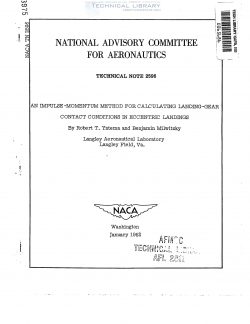naca-tn-2596
- Version
- 182 Downloads
- 2.12 MB File Size
- 1 File Count
- January 9, 2017 Create Date
- January 9, 2017 Last Updated
National Advisory Committee for Aeronautics, Technical Notes - An Impulse Momentum Method for Calculating Landing Gear Contact Conditions in Eccentric Landings

An impulse-momentum method for determining impact conditions for
landing gears in eccentric landings is presented. The analysis is pri-
marily concerned with the determination of contact velocities for
impacts subsequent to initial touchdown in eccentric landings and with
the determination of the effective mass acting on each landing gear.
These parameters determine the energy-absorption requirements for the
landing gear and, in'conjunction with the particular characteristics of
the landing gear, govern the magnitude of the ground loads.
Changes in airplane angular and linear velocities and the magnitude
of landing—gear vertical, drag, and side impulses resulting from a
landing impact are determined by means of impulse—momentum relation-
ships without the necessity for considering detailed force—time varia-
tions. The effective mass acting on each gear is also determined from
the calculated landing—gear impulses. General equations applicable to
any type of eccentric landing are written and solutions are obtained
for the particular cases of an impact on one gear, a simultaneous finpact
on any two gears, and a symmetrical impact. In addition a solution is
presented for a simplified two-degree- of- freedom system which allows
rapid qualitative evaluation of the effects of certain principal
parameters.
The general analysis permits evaluation of the importance of such
initial conditions at ground contact as vertical, horizontal, and side
drift velocities, wing lift, roll and pitch angles, and rolling and
pitching velocities, as well as the effects of such factors as landing-
gear location, airplane inertia, landing-gear length, energy-absorption
efficiency, and wheel angular inertia on the severity of landing
impacts. A brief supplementary study which permits a limited evalua-
tion of variable aerodynamic effects neglected in the analysis is pre-
sented in the appendix.
Application of the analysis indicates that landing-gear impacts in
eccentric landings can be appreciably more severe than impacts in
symmetrical landings with the same sinking speed. The results also
indicate the effects of landing—gear location, airplane inertia, initial
wing lift, side drift velocity, attitude, and initial rolling velocity
on the severity of both initial and subsequent landing-gear impacts.
A comparison of the severity of impacts on auxiliary gears for tricycle
and quadricycle configurations is also presented.
| File | Action |
|---|---|
| naca-tn-2596 An Impulse Momentum Method for Calculating Landing Gear Contact Conditions in Eccentric Landings.pdf | Download |

Comment On This Post